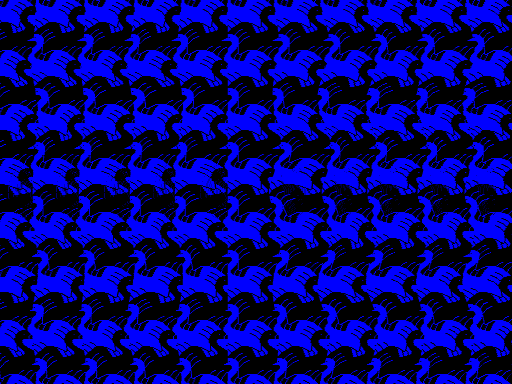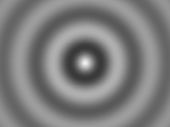
by W.A. Steer PhD
About...

A general introduction to stereograms and their properties, with an example.
I attempt a non-technical explanation of how they work and how they are created.
What is an autostereogram?
Autostereograms represent one of the latest approaches to creating the illusion
of three dimensions. First seen in their current form in 1990, they differ
from earlier 3D technologies in that no special viewing aids are required.
All that is necessary is to diverge ones eyes as if looking through the
screen or paper showing the picture (which is, admittedly, easier said than
done until you get the hang of it).

Fig.1: Stereogram of rippled surface. The central peak should come
towards you. If the centre peak goes away from you then you're looking
cross-eyed rather than wide-eyed. Try again!
Note that the depth in a stereogram becomes more pronounced as you move further
away, and shallower as you bring your face up to the picture. Try it!
The type of stereograms these articles are concerned with are also known as
Single Image Stereograms (SIS), or Single Image Random Dot Stereogram (SIRDS) if
the pattern consists of randomly coloured dots. Various companies have
produced posters and books of stereograms, under the such names as "Hollusion"
and "Magic Eye". Some of the best posters are made by NVision Graphics.
How do autostereograms work?
In normal vision, when looking at a page of text for example, both eyes look
at exactly the same place. With a flat page both eyes see practically the same
thing and hence the brain concludes that the page is indeed flat. Now an
autostereogram picture is basically made up of a pattern which repeats across
the width of the page. When you diverge your eyes to "see" it each looks at
adjacent repeats of the pattern, but the brain is fooled into believing that
both eyes are still looking at exactly the same thing. Since the pattern is
not just copied but is subtly distorted on each repeat, (in accordance with
the three dimensional image represented), the two eyes see slightly different
images. At this point, human perception takes over and the brain concludes
that the differing images arise from looking at a three dimensional object,
whose form it decodes in an instant. Hence the 3D illusion occurs.
...and how are they made?
By computer of course! Actually, the process is rather simpler than you would
imagine. Since the illusion requires you look 'through' the picture, start by
considering a pane of glass in place of the picture. Now imagine a pin placed
behind the sheet of glass, and a ray drawn from the pin-head to each eye (most
peoples eyes are separated by about 7cm or 2.5 inches). Consider the points
where the two rays pass through the glass. If the observer and the glass are
fixed, then as the pin is moved back those points move apart. When the pin is
brought forward, the points come together. Both points always lie on a
horizontal line. The distance between the two points on the glass is related to
the distance of the pin behind the glass by a simple mathematical formula,
known generally as 'similar triangles'.
A stereogram is made by starting with a depth-map describing how deep each
part of the scene is. Frequently this can be seen as a grey-scale picture with
dark areas representing regions that are furthest away, and nearer objects
shown in lighter shades.

Fig.2: Depth-map for the above "ripples"
stereogram (fig.1).
For each point on the depth-map, corresponding pairs of points on the screen
are identified, their separation depending on the depth, and their mean
position coinciding with the original point on the depth-map. The pattern is
then applied, subject to the constraint that both points in any pair must have
the same colour. (Since there are no constraints in the vertical direction,
this process can be worked on a line by line basis.)
See also technical description of my algorithms and programs.


Created: June 1996
Last modified: 23 March 2002
Source: http://www.techmind.org/stereo/sintro.html
©2001 William Andrew Steer
andrew@techmind.org
![]()
![]()



